Reproduction in Plants | Science Class 5 PDF Download
| Table of contents |

|
| Introduction |

|
| Reproduction in Plants |

|
| Asexual Reproduction |

|
| Sexual reproduction |

|
| Pollination |

|
Introduction
Plants are very useful to us. They are the only living beings which make their own food and provide food for all other living beings. Plants also give out oxygen which all human beings and animals need for breathing. Plants also check soil erosion. They are, therefore, called our green friends. Hence, it is necessary to grow more and more plants on earth.
Reproduction in Plants
Living things do not live forever. They all die but life continues due to the process of reproduction. Like animals, plants also reproduce. Plants produce new plants like themselves. This process of production of new plants is called reproduction.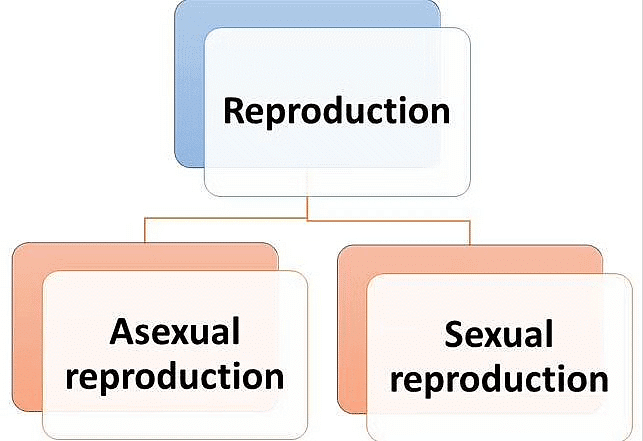
Asexual Reproduction
Asexual reproduction is a mode of reproduction by which offspring arise from a single parent and inherit the character of that parent only. These off-springs are the exact copies of the parent plant.
Vegetative Propagation: The kind of reproduction in which a new plant grows from the body parts of a plant such as the stem, roots and leaves is called vegetative propagation.

1. Vegetative propagation by Roots
A new plant can also grow from the roots of the mother plant. Sweet potato, carrot, radish, turnip and dahlia are some examples of plants whose roots can grow into new plants.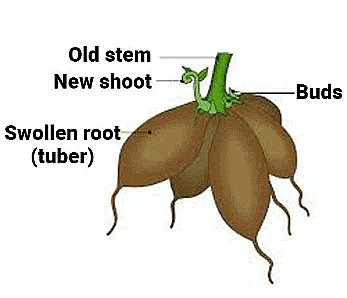 Vegetative Propagation by Roots in Sweet PotatoSome plants like gladioli, lilies and tuberoses grow from the bulbs of the mother plants. The bulbs are underground buds. These are called bulbs because these are shaped like bulbs.
Vegetative Propagation by Roots in Sweet PotatoSome plants like gladioli, lilies and tuberoses grow from the bulbs of the mother plants. The bulbs are underground buds. These are called bulbs because these are shaped like bulbs.
2. Vegetative propagation by Stem
Some plants like rose, hibiscus, money plant and sugarcane can grow from the stems of old plants. A piece of stem having buds is taken from the mother plant and is planted in the soil. After a few days, new plants grow out from the buds. This method is called stem cutting.
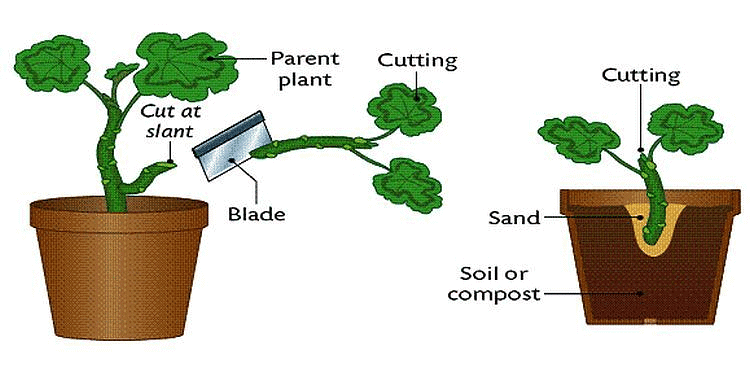
- The potato is a stem that grows underground and has buds called ‘eyes’. Any part of a potato that has buds, when planted in the soil, can grow into a new plant.
- Onion and ginger are also underground stems from which new plants grow.
3. Some plants grow by layering
Some plants can also be grown by layering. In this method, the side branches are bent towards the ground and covered with moist soil, keeping the tip free. After a few days, new roots develop. Jasmine plant and lemon plant reproduce by the process of layering.
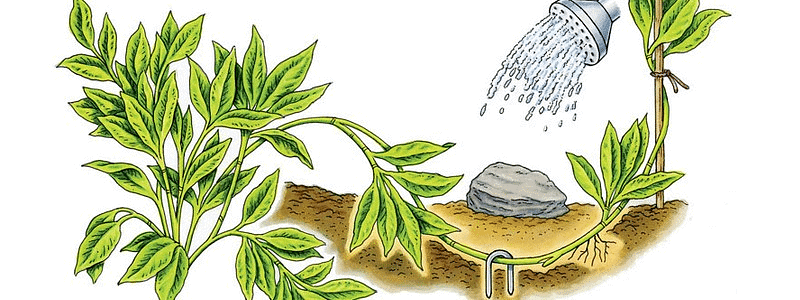 Layering
Layering
4. Growing of grass
We know that grass plants creep along the ground like a green carpet. Side branches grow out of creeping stems. They separate and grow into new plants. These are called runners. Mango, grapes, rose and many other fruit plants are grown by stem cutting and budding.
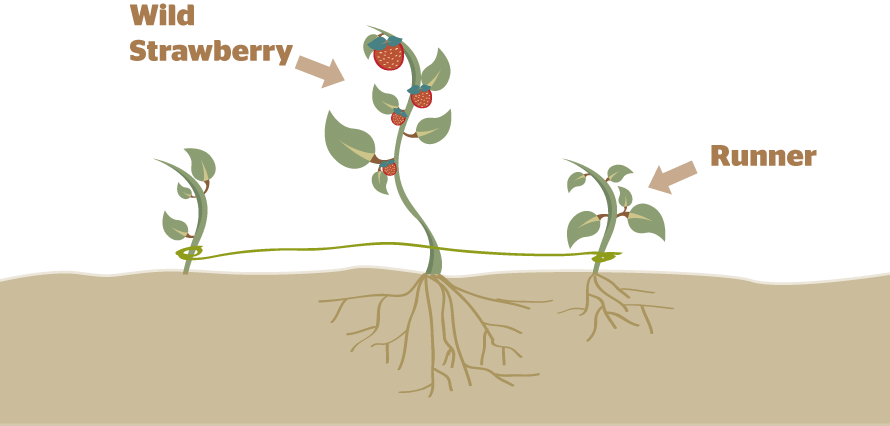
5. Vegetative Reproduction by Leaf
Leaves of certain plants produce buds along their margins. New plants grow from these buds if the leaves are placed in moist soil. For example, Bryophyllum leaves.
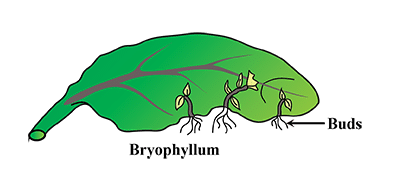 Vegetative Propagation by Leaf in Bryophyllum
Vegetative Propagation by Leaf in Bryophyllum
6. Vegetative propagation by spores
Certain plants do not bear flowers and seeds. They have special structures called spores which help in reproduction. For example, mushrooms, ferns and mosses. If you rub many dark coloured dots lying underside of a fern plant between your thumb and forefinger, the powdery substance you can feel between your fingers are the spores.
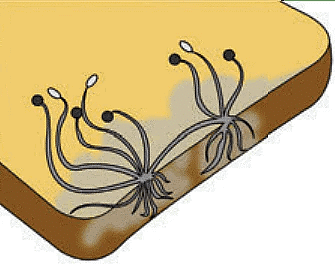 Spores of Fungi
Spores of Fungi
Advantages of Vegetative Reproduction:
1. Vegetative propagation is a faster method to produce a new plant.
2. It is a very useful method for production of seedless plants such as grapes and banana.
3. The plants produced by vegetative propagation bear flowers and fruits earlier than the new plants produced by seeds.
Sexual reproduction
Sexual reproduction is the method of reproduction in plants by which offsprings produce from a male and a female parent. The offspring will inherit the traits of both the parents. Flowers are the reproductive organs of plants. They turn into fruits, which have seeds inside them. New plants grow from seeds.
Interesting Facts:
- Venus fly trap, pitcher plant and bladder worth etc. derive their nitrogen requirement from the insects.
- Bamboo is not a tree but a grass
- The flower of Raffles is the largest known flower
- Edible mushroom grows completely within 7 days.
- Amount of carbon dioxide produced by plants are less than that of oxygen produced by them.
Note: Plants that bear flowers are called flowering plants. Flower turns into fruits and fruits contain seeds. So we can say that flowers are the organs of reproduction for flowering plants.
Parts of a Flower
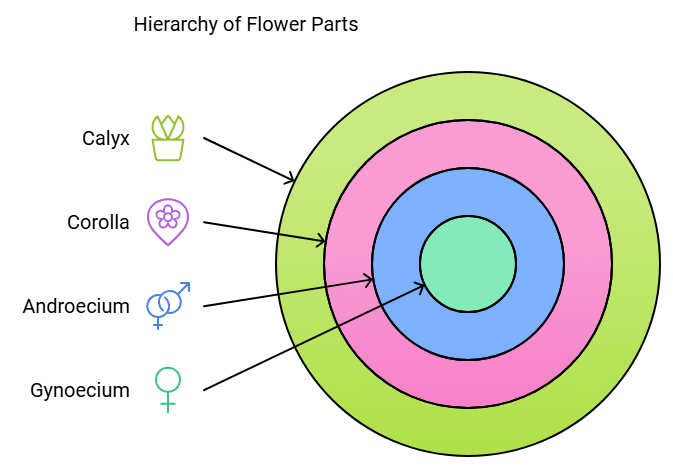
A flower has the following four parts:
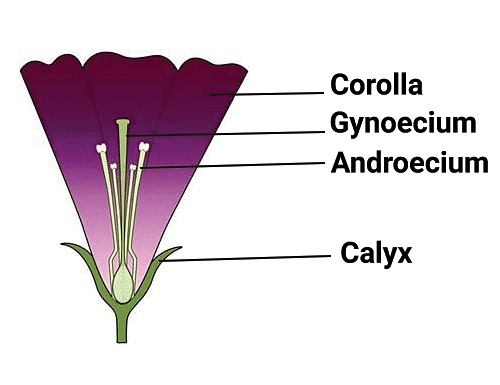
Each of these parts is arranged in a whorl (layer or round pattern) on the base of the flower.
Calyx
- It is the outermost whorl consisting of units called sepals.
- Sepals are green leaf-like structures at the base of a flower and enclose the rest of the flower in the bud stage.
Corolla
- Corolla is the next layer towards the top.
- Corolla is composed of units called petals.
- The petals are soft, brightly coloured, and the most beautiful parts of the flower.
- They attract insects, which help in pollination.
Androecium
- It is the male reproductive whorl consisting of units called stamens.
- The stamen is made up of filaments that have a swollen head at the top called the anther.
- The anther contains a yellow powder-like substance called the pollen grains.
Gynoecium
- Gynoecium is the innermost whorl of a flower, consisting of one or more units called the carpel.
- Carpel is the female part of a flower that consists of a long tube called the style.
- At the bottom of the style, a swollen base called ovary is present. Inside the ovary, ovules are present.
- The uppermost part of the style is called stigma.
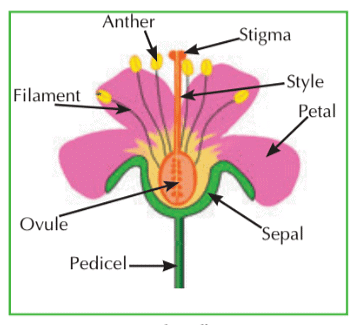
Reproductive Parts of a Flower
- Sepals look like green leaves at the bottom of the flower. They protect the bud.
- In most flowers, petals are brightly colored. They make the flowers look beautiful. They help to attract insects for pollination.
- The stamen is the male part of the flower. It is made up of a thin stalk called the filament with a bag-like head called the anther. The anther contains the pollen grains.
- The pistil is the female part of the flower. It consists of three parts:
1. A swollen base called the ovary. The ovary contains small structures called ovules.
2. A stalk arises from the ovary and is called the style.
3. The style ends at the stigma at the top. - The flower is attached to a stalk called a pedicel. It is enlarged to form a receptacle found at the center of the base of the flower.
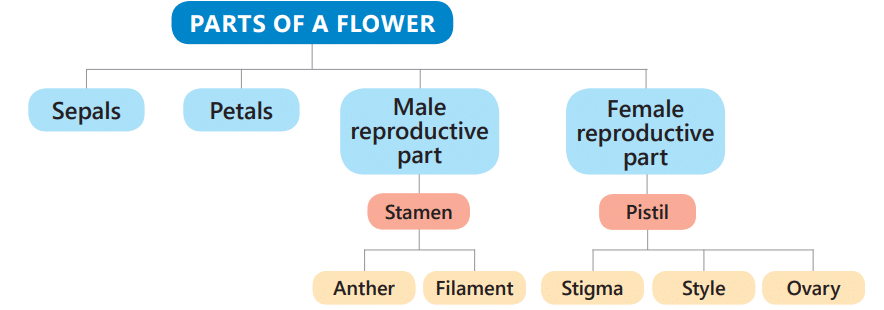
Reproduction in Flowering Plants
Most flowering plants reproduce through seeds. This involves the following steps:
- Adult plants produce flowers.
- Flowers have male and female parts.
- Male parts contain small grains of pollen.
- The pollen grains of one flower are transferred to the female part of the same flower or another flower. This is called pollination.
- After pollination, the petals and stamens fall off. The ovary swells up and changes into a fruit and the ovules change into seeds. This process is called fertilisation.
- These seeds produce new plants. This is the life cycle of a plant.
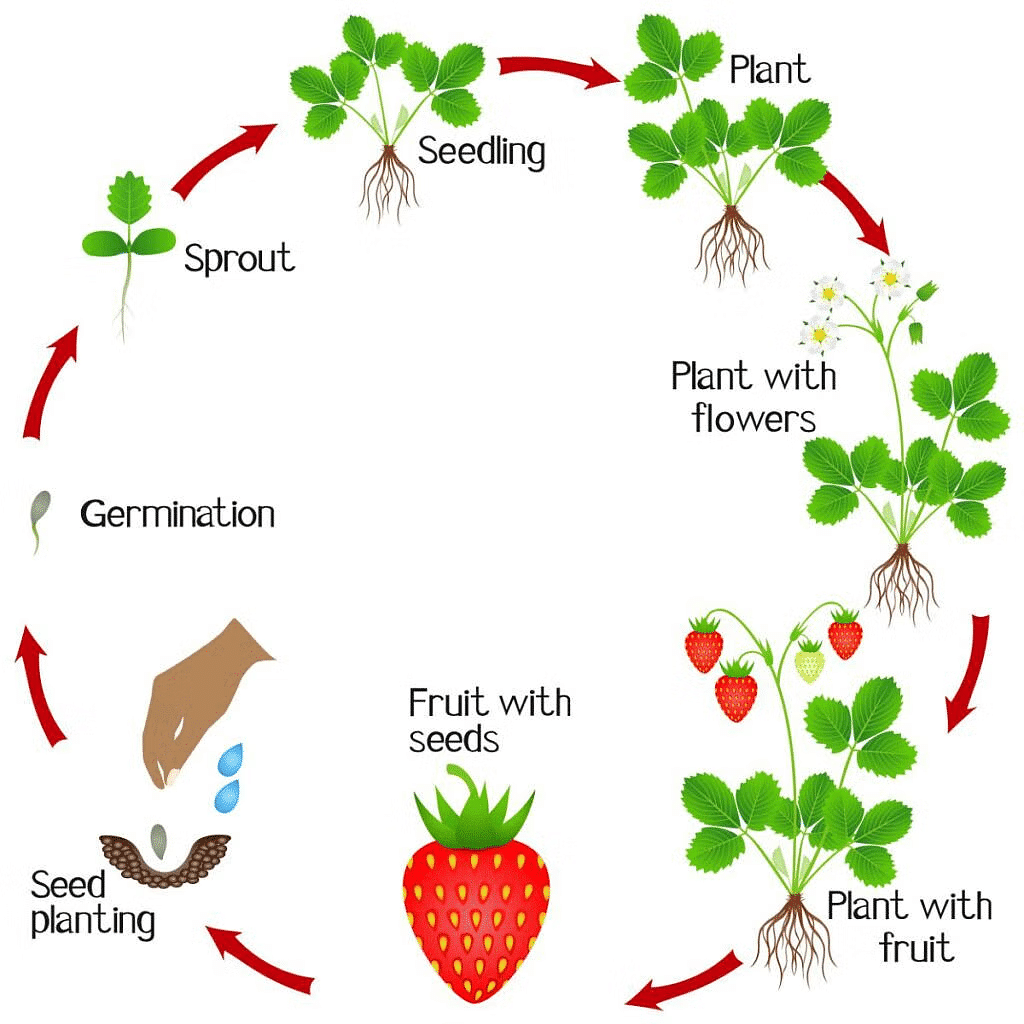
Pollination
The transfer of pollen grains from the anther to the stigma of a flower is called pollination.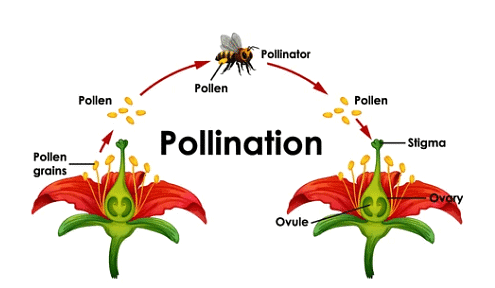
- Birds and insects get attracted to colorful flowers.
- Insects feed on the nectar from the flower, and the pollen grains from the anther stick to their bodies.
- When the insects move to the stigma of a similar flower, the pollen grain falls on the stigma and pollination is carried out.
- After some time, a tube known as the pollen tube comes out of a pollen grain and reaches the ovary through the style.
- When the pollen tube reaches the ovary, fertilization takes place.
- After fertilisation, the ovary of the flower grows into a fruit and the ovule develops into seeds.
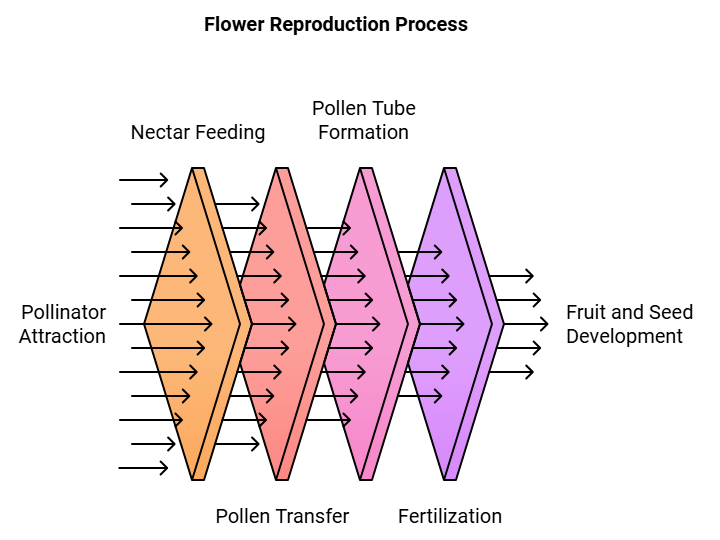
|
42 videos|230 docs|45 tests
|
FAQs on Reproduction in Plants - Science Class 5
| 1. What are the main parts of a flower involved in reproduction? |  |
| 2. How does pollination occur in flowering plants? |  |
| 3. What is the difference between self-pollination and cross-pollination? |  |
| 4. What role do pollinators play in the reproduction of flowering plants? |  |
| 5. Why is reproduction important for plants? |  |
















